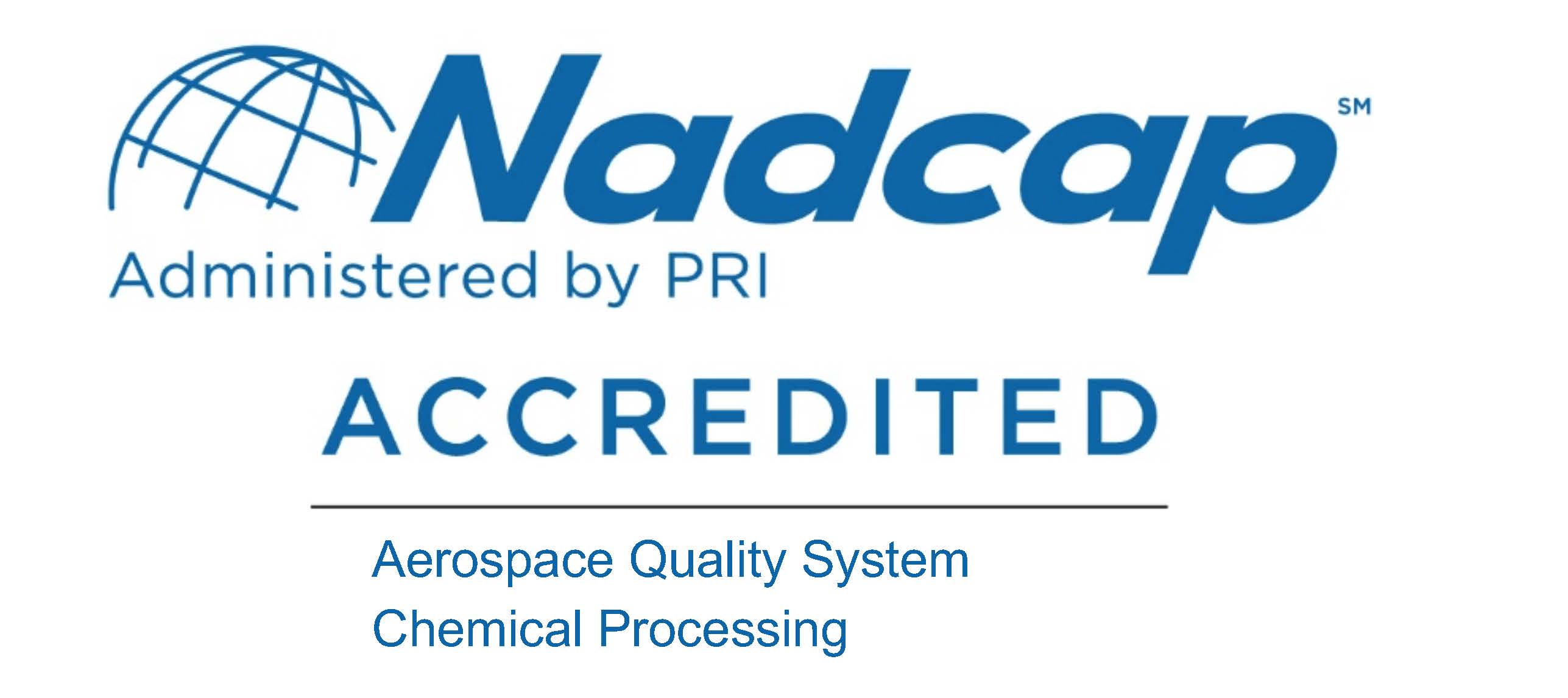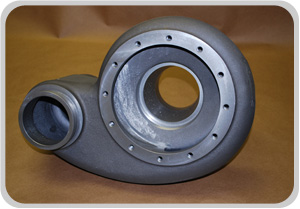


Sulfuric Acid Anodize
Anodizing is a process for producing decorative and protective films on parts made from aluminum and its alloys. The anodic coating provides increased protection from abrasion, wear and corrosion.
The sulfuric anodizing process produces a film of aluminum oxide when direct current at a specified voltage is passed through a diluted sulfuric acid bath. Anodic coatings that are formed as a result of sulfuric acid anodizing can be dyed or left in their natural state. Typical type II anodized coating thickness range from .0002" to 0.001", but varies depending alloy, specification, or customer needs.
Unlike plating, the anodic coating formed from Sulfuric anodizing penetrates and buildups on the surface. The accepted ratio of penetration and buildup is 2/3 penetration and 1/3 buildup. For instance, a coating thickness of 0.0006 would penetrate the substrate .0004" and buildup the substrates surface 0.0002".
Color Chart
|
#2 Lime Green (anodized aluminum)
#4 Green (anodized aluminum)
#6 Forest Green (anodized aluminum)
#7 Olive Drab (anodized aluminum)
#8 Pink (anodized aluminum)
#9 Berry (anodized aluminum)
#10 Dark Pink (anodized aluminum)
#11 Purple (anodized aluminum)
#12 Lavender (anodized aluminum)
#13 Rasperry (anodized aluminum)
#14 Violet (anodized aluminum)
#15 Violet 3D (anodized aluminum)
#16 Turquoise (anodized aluminum) |
#18 Light Blue (anodized aluminum)
#19 Aqua Marine (anodized aluminum)
#20 Blue (anodized aluminum)
#21 Navy Blue (anodized aluminum)
#22 Peach (anodized aluminum)
#24 Brown (anodized aluminum)
#26 Gold (anodized aluminum)
#28 Orange (anodized aluminum)
#30 Red (anodized aluminum)
#32 Clear (anodized aluminum)
#34 Medical Gray (anodized aluminum)
#36 Black (anodized aluminum) |
Specifications
Mil-A-8625 Type II Class 1 or 2
AMS and ASTM specs
PTFE impregnation
Hard Anodize
 Hard anodizing is a term used to describe the production of anodic coatings with film hardness or abrasion resistance as their primary characteristics.
Hard anodizing is a term used to describe the production of anodic coatings with film hardness or abrasion resistance as their primary characteristics.
The coating thickness is greater than that of type II sulfuric or Type I chromic acid anodize and is produced via special anodizing conditions (28-32 degree F solution, high current density, special electrolytes).
The coating differs from plating in that half of the coating penetrates the substrate and half builds up on the surface. Typical hard anodized coating thickness range from .001” to 0.003”, but varies depending alloy, specification, or customer needs.
It is often used for engineering applications for components that require a very wear resistant surface such as pistons, cylinders, and hydraulic gears. Hard anodized parts are often left unsealed to allow for maximum abrasion resistance, but can be sealed with a myriad of solutions to increase corrosion protection or lubricity.
Hard Anodize Features
- Increased wear resistance
- Increased abrasion resistance
- Hardness values up to 70 Rockwell
- excellent dielectric properties (2000VDC)
- Dyed various colors
Applications
- Valves
- Pistons
- Sliding parts
- Medical components
- gears
Hillock Anodizing’s Hardcoat Processes
| Hardcoat (unsealed) | High abrasion resistance |
| Hardcoat (sealed) | High corrosion resistance |
| Hardcoat with ptfe impregnation | Increased lubricity |
| Hardcoat with Dichromate Seal | High corrosion resistance |
| Black and Color Hardcoat |
Specifications
Mil-A-8625 Type III Class 1 or 2
AMS and ASTM specs
PTFE impregnation
Chromic Acid Anodize
 Chromic acid anodizing was the first anodizing process developed. The film obtained in a chromic acid bath ranges from .00002-.0001”.
Chromic acid anodizing was the first anodizing process developed. The film obtained in a chromic acid bath ranges from .00002-.0001”.
This feature of thinness has its advantages to other methods of anodizing because the finish allows for minimal dimensional change and there is not harmful effect on fatigue strength.
Despite the thin anodic coating, the coating is highly protective and corrosion resistant. In addition, chromic acid anodize is beneficial for parts that are subject to stress or there is the possibility that the electrolyte could be trapped in small crevices or substrate imperfections. Chromic acid is non corrosive and will not harm the part if acid is trapped in the metal.
Hillock Anodizing has the ability to dye chromic acid anodized parts black despite the thin film thickness.
Specifications
Mil-A-8625 Type I Class 1 or 2
AMS and ASTM specs
PTFE impregnation
Chromate Conversion Overview
Chromate conversion (also called chemical film, Iridite or Alodine) is a coating applied to aluminum to increase the corrosion resistance of the base metal.
The coating thickness is almost negligible and is a cost effective finish for close tolerance parts. The coating provides excellent adhesion properties and is often used as a base coating for secondary finishes.
Unlike anodize, chromate conversion coatings offer low electrical resistance (class 3 being the lowest) and offers no abrasion resistance. Hillock Anodizing offers chromate conversion in both gold and clear.
In addition to the standard chromate conversion coatings, Hillock offers a RoHS compliant Trivalent chromate. This chromate does not contain hexavalent chromium and offers the same properties as the chrome based conversion coatings. At this time, trivalent chromate finishes are only offered in a clear/iridescent finish.
Specifications
Mil-C-5541 Class 3 or 1A
Mil-DTL-5541 Type I Class 3 or 1A
Mil-DTL-5541 Type II Class 3 or 1A (RoHS compliant chromate)
Electroless Nickel Overview
Electroless Nickel is an autocatalytic plating process that deposits a bright coating of nickel-phosphorous onto the substrate. It provides excellent wear, abrasion, and corrosion resistance.
Due to its ability to form a uniform coating, Electroless Nickel is an excellent choice for parts that are irregularly shaped or have deep recesses, cavities and pockets.
 Plating thickness range from as little as .0001" up to .005" for salvage work. Hillock Anodizing offers high, medium and low phosphorous electroless nickel on aluminum, stainless steel, brass and copper substrates.
Plating thickness range from as little as .0001" up to .005" for salvage work. Hillock Anodizing offers high, medium and low phosphorous electroless nickel on aluminum, stainless steel, brass and copper substrates.
Selective masking and baking options are also available. Baking post Electroless Nickel is used for hydrogen embrittlement relief (steel parts), increasing hardness (steel parts), and improving adhesion of the nickel deposit (aluminum parts).
Specifications
Mil-C-26074 Electroless Nickel Coatings
AMS-C-26074 Electroless Nickel Coatings
AMS-2399 Electroless Nickel/Boron Plating
AMS-2404 Plating, Electroless Nickel
AMS-2405 Electroless Nickel Plating, Low Phosphorus
ASTM B-733 Standard Specification for Autocatalytic Nickel-Phosphorus Coatings on Metals
Passivation
 Passivation improves the corrosion resistance properties of components made of precipitation-hardened, austenitic, ferritic and martensitic steels. Passivation treatments improve the surface condition of stainless steel by dissolving iron or other impurities that has been imbedded in the surface during forming or machining.
Passivation improves the corrosion resistance properties of components made of precipitation-hardened, austenitic, ferritic and martensitic steels. Passivation treatments improve the surface condition of stainless steel by dissolving iron or other impurities that has been imbedded in the surface during forming or machining.
If allowed to remain, the iron can corrode and give the appearance of rust spots on the stainless steel.
Passivation, which consists of immersing stainless steel components in a solution of nitric or citric acid without oxidizing salts, will dissolve the imbedded iron and restore the original corrosion-resistant surface by forming a thin, transparent oxide film.
Hillock Anodizing offers nitric acid passivation and citric acid passivation.
Gold and Clear Chromate
Under Development - Gold and Clear Chromate
Trivalent Chromate
Under Development - Trivalent Chromate
Low Phosphorus EN
Low Phosphorous (1-4% phosphorous) EN is used for high "as deposited" hardness. This coating is uniform, semi-bright and versatile.
This product has superior stability and solderbility. As plated it has a Rockwell of 60. Subsequent heat treat after plating can bring the Rockwell as high as 68.
Mid Phosphorus EN
Mid Phosphorous (5-9%) EN is a very bright coating on steel, copper, brass and aluminum substrates. This coating is uniform and has exceptional hardness as plated with excellent corrosion resistance.
As plated, it has a Rockwell hardness of 46-48. A subsequent heat treat after plating can increase Rockwell to 68. Mid phos electroless Nickel is the most common type of Electroless Nickel and most decorative as well.
High Phosphorus EN
High Phosphorous (10-12% phosphorous) EN is a semi-bright coating ideal for high corrosion resistance with excellent ductility.
This coating can be deposited on steel, aluminum and copper alloys.

























